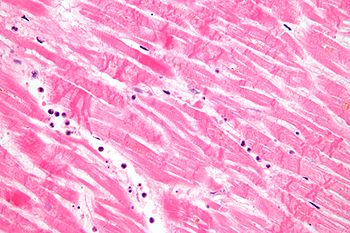Contraction band necrosis
- Contraction band necrosis
-
Contraction band necrosis is a type of uncontrolled cell death (necrosis) unique to cardiac myocytes and thought to arise in reperfusion from hypercontraction, which results in sarcolemmal rupture.[1]
It is a characteristic histologic finding of a recent myocardial infarction (heart attack) that was partially reperfused.
The name of the histopathologic finding comes from the appearance under the microscope; contraction bands are thick intensely eosinophilic staining bands (typically 4-5 micrometres wide) that span the short axis of the myocyte. They can be thought of extra thick striae, typical of cardiac muscle and striated muscle.
Pathophysiology
Contraction band necrosis is thought to arise by two mechanisms:[1]
- a calcium-dependent mechanism - activation of the contractile machinery of the cell via its usual mechanism, calcium, which is in excess due to ischemia.
- a calcium-independent mechanism, as seen in rigor - activation of the contractile machinery in the setting of low ATP.
Reperfusion associated cell death has been modulated (reduced) in animal studies[2] and is an area of active research, which holds the potential to significantly reduce the morbidity (disease burden) and mortality (death) of cardiovascular disease.[1]
Additional images
-
-
Contraction band necrosis. PTAH.
See also
References
- ^ a b c Rodríguez-Sinovas A, Abdallah Y, Piper HM, Garcia-Dorado D (December 2007). "Reperfusion injury as a therapeutic challenge in patients with acute myocardial infarction". Heart Fail Rev 12 (3-4): 207–16. doi:10.1007/s10741-007-9039-9. PMID 17530396.
- ^ Garcia-Dorado D, Inserte J, Ruiz-Meana M, et al. (November 1997). "Gap junction uncoupler heptanol prevents cell-to-cell progression of hypercontracture and limits necrosis during myocardial reperfusion". Circulation 96 (10): 3579–86. PMID 9396458.
External links
Wikimedia Foundation.
2010.
Look at other dictionaries:
contraction band necrosis — a cardiac lesion seen in patients with neurologically induced cardiographic changes, in myocardial biopsy specimens, and in cocaine or epinephrine toxicity, characterized by hypercontracted myofibrils with contraction bands and mitochondrial… … Medical dictionary
Necrosis — For the film, see Necrosis (film). Necrotic leg wound caused by a brown recluse spider bite Necrosis (from the Greek νεκρός, dead , νέκρωσις, death, the stage of dying, the act of killing ) is the premature death of … Wikipedia
band — 1. Any appliance or part of an apparatus that encircles or binds a part of the body. SEE ALSO: zone. 2. Any ribbon shaped or cordlike anatomic structure that encircles or binds another structure or that connects two or more parts. See fascia,… … Medical dictionary
necrosis — Pathologic death of one or more cells, or of a portion of tissue or organ, resulting from irreversible damage; earliest irreversible changes are mitochondrial, consisting of swelling and granular calcium deposits seen by … Medical dictionary
Histopathology — Micrograph showing contraction band necrosis, a histopathologic finding of myocardial infarction (heart attack). Histopathology (compound of three Greek words: ἱστός histos tissue , πάθος pathos disease suffering , and λογία logi … Wikipedia
Myocardial infarction diagnosis — Main article: Myocardial infarction A diagnosis of myocardial infarction is made by integrating the history of the presenting illness and physical examination with electrocardiogram findings and cardiac markers (blood tests for heart muscle cell… … Wikipedia
Timeline of myocardial infarction pathology — This table gives an overview of the pathology seen in myocardial infarction by time after obstruction. For the first 30 minutes no change at all can be seen by gross examination or by light microscopy in histopathology. However, in electron… … Wikipedia
stone heart — massive contraction band necrosis in an irreversibly noncompliant hypertrophied heart, occurring as a complication of cardiac surgery; it is believed due to a combination of low levels of adenosine triphosphate and calcium overload … Medical dictionary
syndrome — The aggregate of symptoms and signs associated with any morbid process, and constituting together the picture of the disease. SEE ALSO: disease. [G. s., a running together, tumultuous concourse; (in med.) a concurrence of symptoms, fr. syn,… … Medical dictionary
digestive system disease — Introduction any of the diseases that affect the human digestive tract. Such disorders may affect the esophagus, stomach, small intestine, large intestine (colon), pancreas, liver, or biliary tract. A prevalent disorder of the digestive… … Universalium



